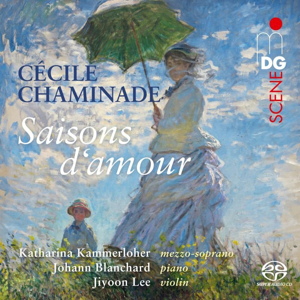
Cécile Chaminade (1857-1944)
Saisons d‘amour
Katharina Kammerloher (mezzo-soprano)
Johann Blanchard (piano), Jiyoon Lee (violin)
rec. 2022, Konzerthaus, Abtei Marienmünster, Marienmünster, Germany
Sung texts with English translations enclosed
Reviewed as download from press preview
MDG 90822886 SACD [59]
Though Cécile Chaminade was successful and highly regarded, both as composer and pianist during the second half of the 19th century, her star waned after the turn of the century, when new trends made her compositional style seem dated. Her songs had been performed by the greatest singers, like Emma Albani, Blanche Marchesi and Pol Plançon. The new audiences frowned upon them and called them salon pieces. But tastes can change again, and today her chamber and piano works are frequently performed and recorded – even her own acoustic recordings from the beginning of the previous century are available on CD. Also her despised salon songs have found favour with the elite of present-day singers. I have for more than twenty years treasured a DG recording with Anne Sofie von Otter and Bengt Forsberg. Besides twenty-five songs, the disc includes three pieces for violin and piano and three for two pianos. It must still be counted as one of the best tributes to Cécile Chaminade’s art. Now comes Munich-born Katharina Kammerloher, who was brought to the Staatsoper unter den Linden by Daniel Barenboim in 1993, and this autumn she is scheduled to sing in Elektra in the house – staying power indeed! – and here, recorded in September and October last year her voice is in fine fettle. Chaminade composed more than 125 songs and it is interesting to note that of the twenty-two songs she has chosen for her programme, only one overlaps with von Otter’s choices: L’été (track 11), and it’s not even the same version, since Kammerloher sings it in an arrangement by Christian Dallacher for voice, violin and piano.
In the liner notes Katharina Kammerloher explains her principles for building the programme: “I consciously took my lead from the song texts. This process led to a kind of cyclic form that I would call “Saisons d’amour”–“seasons of love”, a poetic reflexion on the various phases of life and love among men and women.” The first half of the cycle depicts love and youth developing in the Spring, everything blossoming “until in L’été the whole pageant culminates in a musical firework display, the joie de vivre of Summer”. In the second half it darkens, and we encounter the reverse side of the coin: sorrow, sadness, longing. Not least old people’s longing for “the Summer of Love”. In the last song, Portrait, we are back where we started: Spring! “The wheel turns full circle” as Katharina Kammerloher expresses it.
The songs are melodious, varied and harmonically subtle and the accompaniments are expressive – a lot more than a discreet background. Several have the air of the salon – in a positive sense. La plus jolie (track 7) certainly caresses the ear, as do several others. Sérénade Sévillane (track 6) has Spanish flavour and is light-hearted and from my perspective there isn’t a weak song in the first half of the cycle. Madrigal (track 9) provides an extra frisson and the concluding L’été (track 11) is light and charming – even exuberant and jubilant; a real tour de force of singing, too.
The second half, though sorrowful and tragic, is musically just as strong and possibly even more substantial emotionally. There are many deeply touching moments here, and it is strictly speaking unfair to highlight individual songs, since the sum is greater than the single pieces, but for those who want to sample before buying, I recommend the inward, gently rocking Berceuse (track 17) and the achingly beautiful Infini (track 21) with violin. The final song, Portrait (track 22) is a kind of independent encore, balm for the soul after all the dark moments. It is a light-hearted waltz in the manner of Strauss with languorous violin accompaniment.
It was a stroke of genius to structure this programme as a cycle, and I believe it would make its mark even in a mediocre performance, but Katharina Kammerloher’s reading, abetted by the accompaniment of Johann Blanchard and the heavenly tones from Jiyoon Lee’s Stradivarius violin, is certainly not mediocre; her tone is absolutely steady with a light, piquant vibrato. She phrases elegantly and musically, is careful with nuances and has also the power for the dramatic outbreaks. Most important of all is her deep involvement and feeling; the texts mean something to her – and the songs in themselves are wonderful.
Göran Forsling
Help us financially by purchasing from



Contents
1 Plaintes d’amour / Love’s complaint / Liebesklagen 1’24
2 Avril s’éveille / April awakes / April erwacht 1’47
3 Fragilité / Fragility / Zerbrechlichkeit 3’41
4 Serenata / Serenade / Serenade 1’50
5 Absence / Absence / Abwesenheit 2’29
6 Sérénade Sévillane / Seville Serenade / Sevilla Serenade 2’45
7 La plus jolie / The prettiest / Die Schönste 2’30
8 Souhait / Wish / Wunsch 2’00
9 Madrigal / Madrigal / Madrigal 2’15
10 Mon cœur chante / My heart sings / Mein Herz singt 1’44
11 L’été / Summer / Der Sommer 3’52
(arr. for voice, violin and piano by Christian Dellacher)
12 Madeleine / Madeleine / Madeleine 2’53
13 Chanson naïve / Naive Song / Naives Lied 2’23
14 La Fiancée du soldat / The Soldier’s fiancée / Die Verlobte des Soldaten 3’33
15 Roulis des grèves / Roll of the swell / Rollen der Dünung 2’28
16 Le beau chanteur / The beautiful Singer / Der schöne Sänger 2’38
17 Berceuse / Lullaby / Wiegenlied 2’27
18 Avenir / Future / Zukunft 3’28
19 Jadis ! / Once! / Einst! 2’04
20 Vœu suprême / Supreme Wish / Höchster Wunsch 3’18
21 Infini / Infinity / Unendlichkeit 3’04
22 Portrait / Portrait / Porträt 4’23


















